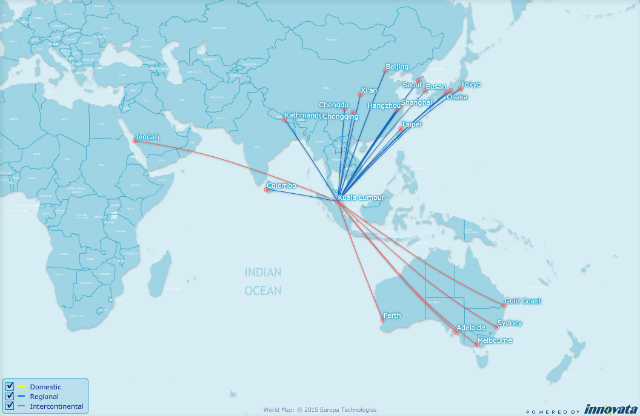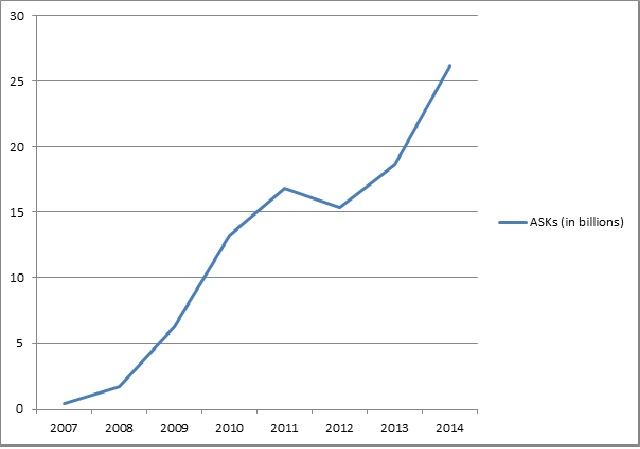Big changes appear to be underway for Malaysian long-haul low-cost carrier AirAsia X (AAX), following the abrupt departure of chief executive Azran Osman-Rani in late-January.
AAX subsequently appointed Kamarudin Meranun to the newly created role of chief executive of the AAX Group, which encompasses AAX, Thai AAX and Indonesia AAX.
At the same time, AAX announced a proposed rights issue that should raise up to MYR395 million ($108 million) to repay borrowings and to fund its working capital.
The rights issue is seen as a reaction to the consecutive losses in the last three quarters, as the airline boosted capacity at the expense of yields. AAX had reported an operating loss of MYR308 million for the first nine months of 2014, and a net loss of MYR351 million.
In a previous interview with Flightglobal, Azran said that some of the airline’s “earning pressures are a result of [their] own doing, as it pays for growth”, and that it is “deliberate with [its] IPO strategy that money raised will fund growth.”
It appears, however, that AirAsia X's shareholders may have lost patience with the strategy of taking hits now with an eye to the long-term. The company's stock has fallen about 40% in the last 12 months, and the long-haul, low-cost business model has some way to go before being universally accepted as a viable way of running a carrier.
Shukor Yusof, founder of aviation advisory firm Endau Analytics, questions whether Azran is solely to blame for AAX’s current straits.
“The business model [of building scale] was crafted by the senior management of the group and any shortcomings need to be addressed accordingly, " he says. "[But] as chief executive, the buck understandably stops with [Azran],” he adds.
Concerns about mounting losses are starkly evidenced by its cutting of destinations and delaying of aircraft deliveries.
Although AAX still flies to 19 destinations, it recently cut Kuala Lumpur-Nagoya and will be removing Kuala Lumpur-Adelaide.
AirAsia X destinations - February 2015

FlightMaps Analytics
In addition, AAX will take delivery of only four aircraft in 2016 instead of the planned eight, with the remaining four aircraft converted to A330neos for delivery from 2018 onwards. Similarly, it will take delivery of five aircraft in 2017, with three to be converted to A330neos for delivery after 2018.
More pertinently, the reduction of aircraft deliveries indicates that the airline is finally tweaking its expectations and wants to execute its growth strategy less aggressively.
Flightglobal’s Capstats shows that AAX’s capacity grew by 29% from 2013 to 2014, and and 17.2% from 2012 to 2013. Reduced aircraft deliveries likely means that the airline’s capacity will grow at a slower rate for the next few years.
AirAsia X’s annual capacity growth - 2007 to 2014

Capstats
As for incoming boss Kamarudin, Michael Hui, aviation analyst at Flightglobal Ascend Consultancy, says the former's role will be to help implement a turnaround plan for AAX. Kamarudin's remit, Hui feels, will be strengthening its balance sheet and to maximize profitability, and ensuring a stronger financial footing for the company.
Yusof, however, says that there is no guarantee Kamarudin can make the company profitable “unless he finds the magic potion that has so far eluded many who tried to go long-haul, low-cost”.
“[AAX] was premised on the belief that there will be sufficient demand for traffic in the long-haul, low-cost market. As we have seen, it isn't easy to achieve success with this model.”
That said, Yusof feels that Kamarudin “brings a steady hand and an in-depth understanding of the markets”. And as co-founder of AirAsia, Kamarudin’s taking of the reins “instills confidence to the company’s creditors and investors – or so the group hopes.”
On the formation of the new AAX Group, Yusof says that this new strategy “will allow senior management to see at a glance how each unit is performing vis-à-vis their competitors, and brings cohesiveness and a streamlining of revenue flow”.
One potential issue of this set up, he feels, is that the “weakness of one subsidiary could drag the others down."
Hui also believes the new AAX Group will be a positive restart for the airline. “It is definitely beneficial for AAX to group all its over overseas affiliates under one ambit to strengthen its Southeast Asia market.”
“This is the right direction for AAX to be heading, in order to build stronger networks within SouthEast Asia, as it lacks interline partnership with other airlines,” adds Hui.
He cites AAX’s regional low-cost rivals Citilink and NokScoot of Indonesia and Thailand, respectively, as carriers that have networking partnerships with their parent companies in such countries.
“Obviously [other low-cost airlines] have benefited from AAX’s folly of mass expansion and over-exuberance. But the low-cost, long-haul market is extremely hard to crack. I'd say the odds are 50:50,” adds Yusof.
Source: Cirium Dashboard



















